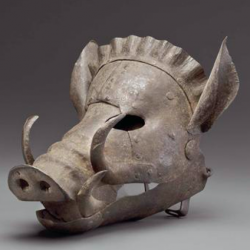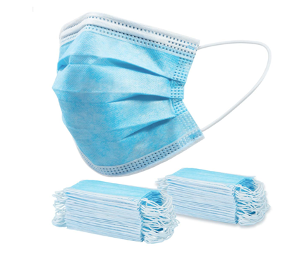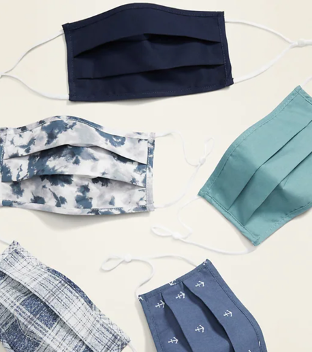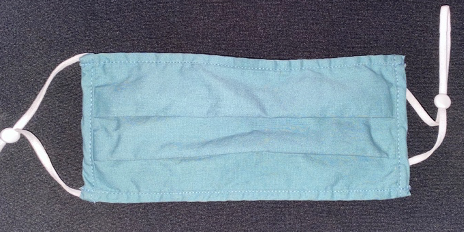Grace Tinklepaugh Dr. Alla Myzelev ARTH 300: Fashion, Art, and Politics Spring 2021
Noh theatre is a form of Japanese drama that has been around since the early 1300s. It is well-known for its glamorous and intricate costumes and masks.

Noh masks are often used to represent the supernatural or animals in theatre. Noh theatre is a drama formulated around song and dance. This type of Japanese drama is well known for the elaborate costume, makeup, wings, and masks which add to the elements of the performance and the attributes of the characters. Noh Theatre is known for its extravagant music, dance and drama and themes of dreams, supernatural, and spirits. The masks are made of wood and hand painted using a style that date back thousands of years. These masks are often hundreds of years old and passed down to others. There are many different types of Noh masks that are used for specific plays and performances. The masks are used to amplify the drama of Noh theatre, and often represent spiritual beings and animals. The masks are hand painted and known for being gorgeous and detailed. Noh theatre and masks influenced future Japanese traditions in the arts.

In Japan masks were very popular and common both in the arts and society. From surgical masks to fashion to art, masks have been incorporated in many aspects of Japanese life. Deriving from historic religious rituals, masks have been a major part of Japanese culture since the beginning. In Japanese theatre there are multiple types of Noh masks. In the past, there used to be up to 60 different types of Noh masks used in theatre. Currently now, there are over 200 types of Japanese Noh masks used in theatre, all stemming from the traditional Noh masks of the early 1300s. The masks represent animals, specific characters, non-human characters, and the supernatural.

Noh theatre masks are made of a lightweight wood, for actors to wear for long periods of time. They are decorated with natural pigment using seashells and glue, along with paint. The masks are made to be worn during long periods of time and can handle a range of actions that the actor might be performing.

Noh theatre is a very popular form of Japanese theatre representing dance, drama, glamorous costumes, and elaborate makeup and masks. This form of theatre is an all-male performance that was founded in the early 1300s. This classical theatre is well known for its extravagant costume and masks, that are essential to the characters identity and plot of the theatre.

Noh theatre inspired many traditions and trends later on in Japanese culture and society. This genre of theatre is often very dramatic and extravagant, in both its content and costume. The costumes are extremely luxurious and typically very vibrant with color and patterns. It is very common in Noh costume and masks to have bright vibrant colors. The colors often have a deeper meaning in this style of theatre. For positive traits and characters, the costume and masks include the colors: red and purple. Whereas the negative and villainous characters are represented by the colors: blue, black, and green.

One of the most popular and notable Noh masks is called the Hannya. The Hannya represents an evil female demon that has horns, sharp teeth, and metallic eyes. The mask represents jealousy and traditional bridal headwear. In Noh theatre all of the actors are male, which is why the masks are often used to portray female characters. In Japanese theatre, the main character often wears the Noh mask, along with the accompanying character (usually playing as a female character). Not only do Noh masks represent a specific character, they also represent emotions. The emotions often represented on Noh masks are sadness, anger, and happiness. Another popular character depicted by Noh masks is Oni. Oni is a red-faced demon and was worn by parents to remind their children of the dangers of demons. Children would throw beans at this mask to cast away the demon. Other notable characters depicted by specific masks were Tengu (a birdman who scared away bad spirits), Shinto (a magical shape shifting fox), and Hyottoko (a clown).

Masks are an essential part of Noh theatre. The masks play an important role in the theatre, the main character and accompanying character(s) almost always wear masks. However, the narrator in Noh theatre never wears a mask. The masks have set roles in Noh theatre and only specific characters can wear them. There are many different types of masks in Noh theatre categorized in a few basic ways. Some of the categories used to organize Noh masks are: otoko (human male), jo (elderly), onna (woman), uba (old woman), chigo (children), jinki (the supernatural), kijin (demons), and animals. Not only were masks used in plays, they were often depicted in Japanese artwork as well. Japanese artist frequently liked to paint and depict Noh masks on Japanese prints. Noh themes, scenes, and masks were popularly portrayed on Japanese art prints during the late 18th and 19th century. Noh masks have been appreciated and admired continuously since the early 14th century into the present. Japanese prints depicting Noh masks are still being sold and created in the present. Masks have been extremely influential in Japanese tradition, culture, and art. The masks are well respected and appreciated as an art form in multiple ways. Noh masks have also inspired makeup and art among common people. The art form has been extremely influential in society, even among common people. The continuous popularity shows how rich in culture and tradition Japanese art is. Noh was not exclusively for any group of people and was often very popular among commoners. Noh theatre is often described as the “people’s dramatic art”.

Noh theatre has changed a lot throughout history, but the main principles and characteristics of this art form remain and are still appreciated to this day. Noh masks are an essential part of Japanese theatre and culture. These intricate and gorgeous masks represent tradition, culture, art, and history. Noh drama and theatre masks represent a variety of characters that were not only important in theatre, but in traditional stories shared and passed down within families. Noh masks were influential to later artistic developments in Japan, like Japanese art prints.

Japanese masks are still purchased and appreciated to this day. These masks are still very popular in Japanese culture as they are still remembered through childhood tales, theatre, and art.

Works Cited
“Back Matter.” Asian Theatre Journal, vol. 20, no. 1, 2003. JSTOR, www.jstor.org/stable/1124065. Accessed 7 Apr. 2021.
“Japanese Masks in Noh Theater and Kabuki.” Artelino, www.artelino.com/articles/japanese-masks.asp. Accessed 14 Apr. 2021.
“Masks.” Traditional Kyoto, traditionalkyoto.com/culture/masks/. Accessed 14 Apr. 2021.
“Noh Masks.” Kabuki Mask, kabukimask.com/. Accessed 14 Apr. 2021.
“Noh Theatre.” Japan-Guide.com, www.japan-guide.com/e/e2091.html. Accessed 28 Apr. 2021.
Pronko, Leonard C. “Kabuki Today and Tomorrow.” Comparative Drama, vol. 6, no. 2, 1972, pp. 103–114. JSTOR, www.jstor.org/stable/41152579. Accessed 7 Apr. 2021.
Scott, Adolphe Clarence. The Kabuki Theatre of Japan. E-book.
Stewart, Elizabeth. “Unmasking the Value of a Traditional Japanese Art Form.” Elizabeth Appraisals, elizabethappraisals.com/1960s-kabuki-masks/. Accessed 14 Apr. 2021.





